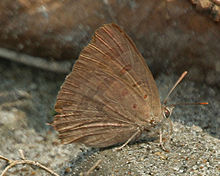Arhopala
They occur from Japan throughout temperate to tropical Asia south and east of the Himalayas to Australia and the Solomon Islands of Melanesia.
[1][failed verification] The genus' delimitation versus Amblypodia and Flos has proven to be problematic; not all issues are resolved and the assignment of species to these genera must be considered somewhat provisional.
For example, A. phryxus – the type species used by Jean Baptiste Boisduval when he described Arhopala in 1832 – was established at the same time as and specifically for this genus.
It is considered to be a valid species of unclear affiliations, but it is suspected that Boisduval's taxon is a junior synonym of A. thamyras – the namesake of its species group – which had been described as Papilio thamyras by Carl Linnaeus already in 1764.
[2] Molecular phylogenetic studies have only sampled a fraction of the known diversity of oakblues, but as it seems at least some of the groups represent clades that could justifiably be treated as subgenera.











